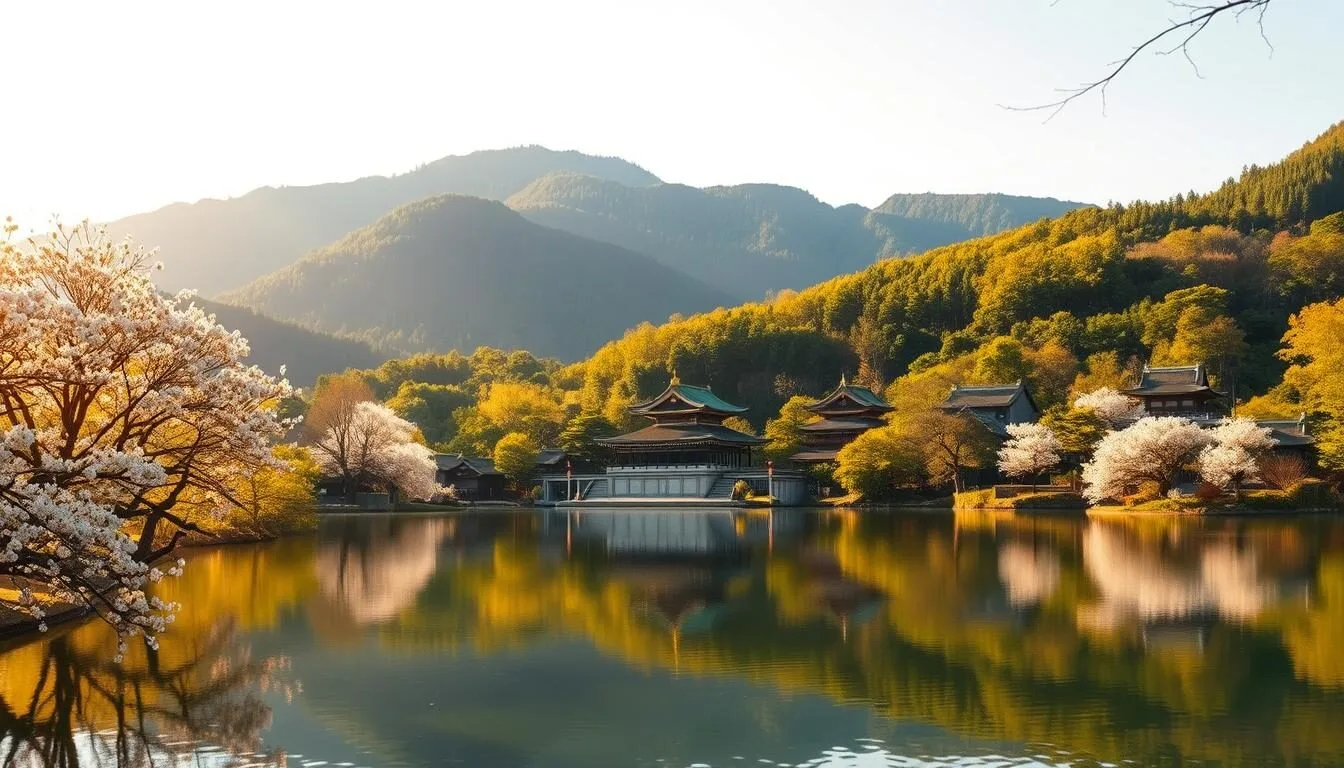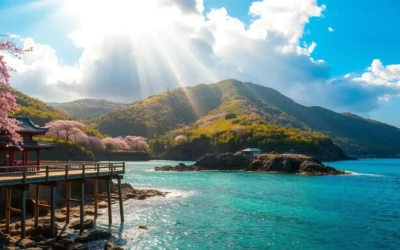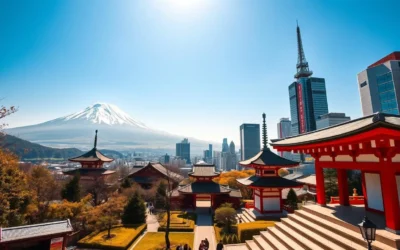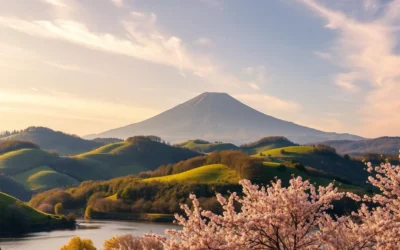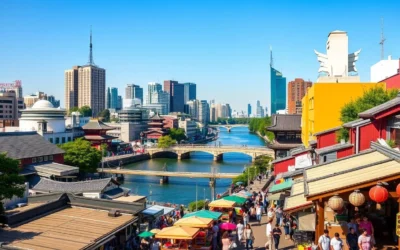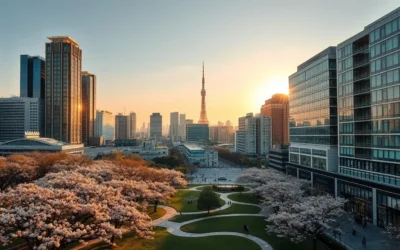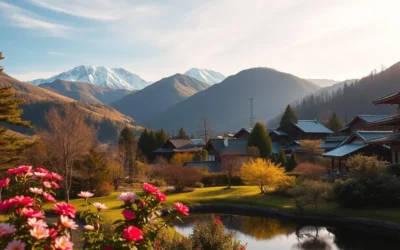Planning a trip to Mie Prefecture requires understanding its unique seasonal patterns to make the most of your Japanese adventure.
Located in central Japan, this region offers diverse experiences throughout the year, from delicate cherry blossoms in spring to vibrant autumn foliage.
To determine the ideal time to visit based on weather patterns, seasonal attractions, and local festivals, this guide will explore each season’s unique characteristics.
By timing your visit strategically, you’ll enhance your travel experience, whether you’re seeking cultural immersion, outdoor adventures, or culinary delights.
Understanding Mie Prefecture’s Climate and Geography
As you plan your trip to Japan, understanding the climate and geography of Mie Prefecture is crucial for a weather-savvy visit. Mie Prefecture, situated in the Kansai region, boasts a unique geography that influences its climate, making it an attractive destination throughout the year.
Where is Mie Prefecture Located?
Mie Prefecture is located on the eastern coast of the Kii Peninsula, facing the Pacific Ocean. This strategic location has played a significant role in shaping its history, culture, and climate. The prefecture is bordered by several other regions, including Nara and Wakayama, contributing to its diverse cultural and geographical characteristics.
The varied landscape of Mie, ranging from coastal areas to mountains, creates a fascinating environment for visitors. The prefecture’s geography is characterized by its long coastline, which has been crucial for its historical development and continues to be a significant aspect of its identity.
General Climate Patterns of Mie Prefecture
Mie Prefecture experiences a temperate climate, with four distinct seasons. The region’s climate is influenced by its proximity to the Pacific Ocean, which moderates temperatures and contributes to the area’s mild winters and warm summers. The changing seasons in Mie offer a range of experiences for visitors, from the blooming cherry blossoms in spring to the vibrant autumn foliage.
The general climate patterns in Mie are characterized by mild temperature extremes compared to other parts of Japan, such as Tokyo or Osaka. This makes Mie an attractive destination for those seeking comfortable weather conditions throughout the year.
How Mie’s Weather Differs from Other Japanese Regions
Mie Prefecture’s weather is distinct from other Japanese regions in several ways. Unlike northern Japan, Mie rarely experiences heavy snowfall in winter, making it more accessible year-round. Its position on the Pacific coast means it’s less affected by the heavy winter snow that impacts Japan’s Sea of Japan coast. The prefecture’s climate is generally milder, with more comfortable conditions during both summer and winter.
- Mie’s mountainous interior creates microclimates that can differ significantly from coastal areas, providing diverse weather experiences within a small geographical area.
- The region’s unique position means that the cherry blossom and autumn foliage seasons may occur at slightly different times than in other popular Japanese destinations.
Spring in Mie Prefecture: March to May
Spring in Mie Prefecture is a time of renewal and natural beauty. As the cold winter months fade away, the region transforms into a vibrant landscape full of life and color. This season is particularly appealing to tourists who enjoy mild weather and the various festivals that take place during this time.
March: Early Spring Awakening
March marks the beginning of spring in Mie Prefecture, with early blooms and the gradual warming of the weather. It’s an excellent month for those who want to experience the initial awakening of spring without the crowds that come later. You can enjoy the serene landscapes and the early spring flowers that start to bloom.
April: Cherry Blossom Season
April is the peak of spring in Mie Prefecture, with the famous cherry blossom season reaching its climax. The prefecture is dotted with beautiful cherry blossom viewing spots, making it a paradise for those who enjoy this traditional Japanese experience. Some popular spots include:
– Tsu Castle Park
– Suzuka National Park
– Ise Grand Shrine grounds
You should plan your visit to coincide with the blossoms for an unforgettable experience.
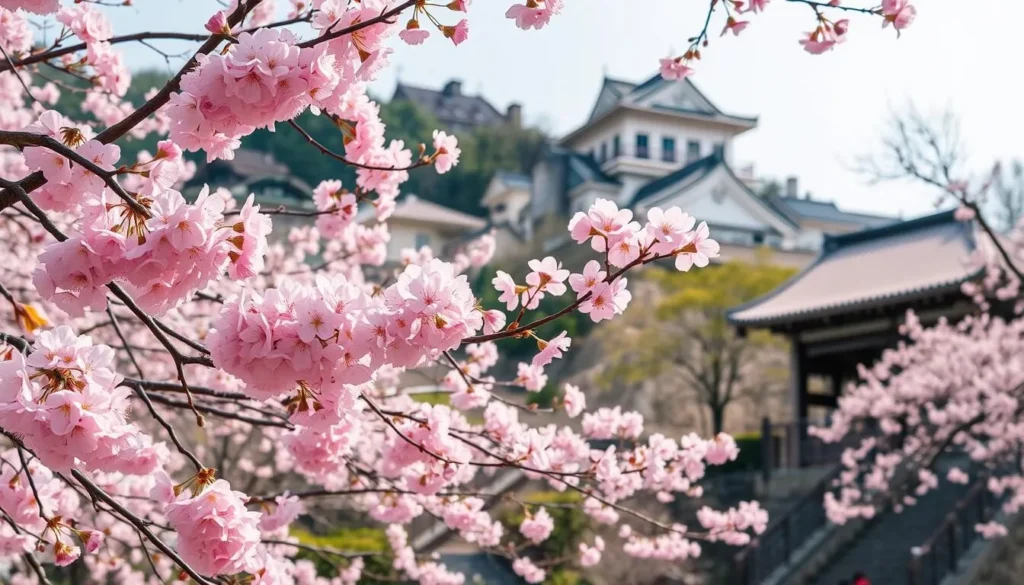
May: Pleasant Weather After Golden Week
May is a fantastic time to visit Mie Prefecture, especially after the Golden Week rush. The weather is consistently pleasant, with average temperatures ranging from 20-25°C (68-77°F), making it ideal for outdoor activities. The landscape is lush and green, with late-blooming flowers adding color to the parks and natural areas. You can enjoy hiking, visiting historical sites, or simply taking in the beauty of nature without the crowds.
- After the Golden Week crowds disperse, Mie Prefecture becomes significantly less crowded.
- Temperatures are consistently pleasant, averaging 20-25°C (68-77°F).
- The landscape is lush and green, with late-blooming flowers creating colorful displays.
- May offers an excellent balance of good weather, reasonable prices, and manageable tourist levels.
Summer in Mie Prefecture: June to August
The summer season in Mie Prefecture, spanning from June to August, is characterized by hot and humid weather, along with numerous festivals and events. This period is considered peak travel season due to school holidays and the Obon Festival, attracting many people.
June: Navigating the Rainy Season
June marks the beginning of summer in Mie Prefecture, but it’s also the month of the rainy season, known as “tsuyu” or “baiyu.” During this time, the region experiences increased rainfall and humidity. While this might deter some travelers, it’s also a period when the landscape is particularly lush and green. Visitors can enjoy the beautiful scenery and fewer crowds at popular spots, making it a good time for those who prefer a more relaxed atmosphere.
July: Heat, Humidity, and Summer Festivals
July brings the onset of hot and humid weather, with temperatures rising significantly. Despite the challenging climate, July is a vibrant month filled with summer festivals, or “matsuri,” which are an integral part of Japanese culture. These festivals often feature traditional dances, food stalls, and fireworks, offering a unique cultural experience. Visitors can immerse themselves in local customs and enjoy the energetic atmosphere of these events.
August: Peak Summer Activities and Obon Festival
August is the peak of summer in Mie Prefecture, with temperatures often reaching 32-37°C (90-99°F) and high humidity. The month is filled with various festivals, including the significant Obon Festival in mid-August. During Obon, many Japanese people return to their hometowns to honor their ancestors, leading to increased domestic travel. Coastal areas become popular for swimming and water activities, with the Shima Peninsula being a favorite destination. The night skies are illuminated by spectacular fireworks displays, or “hanabi,” over cities like Tsu, Matsusaka, and Ise.
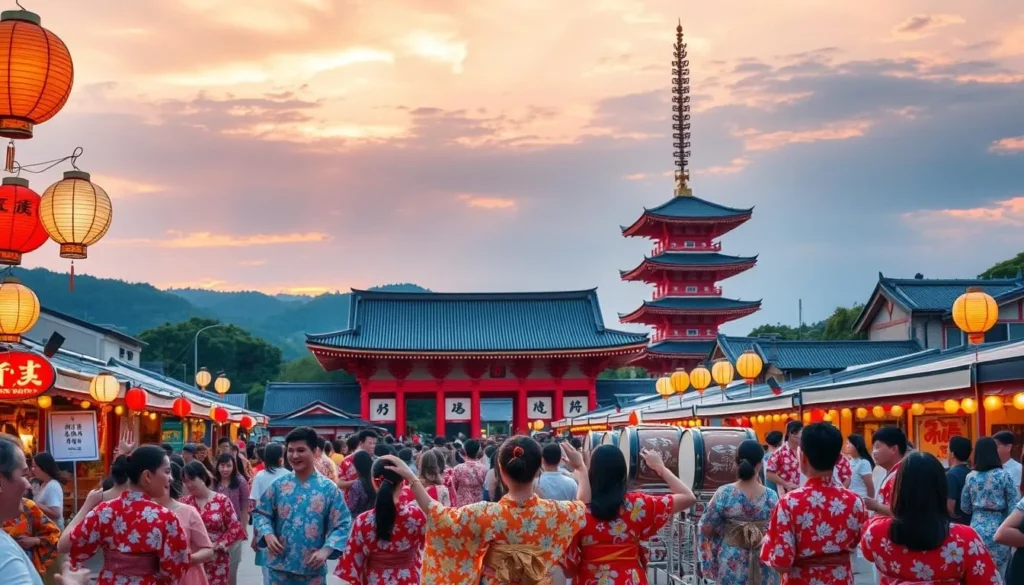
Despite the challenging daytime heat, August offers vibrant cultural experiences and the opportunity to witness traditional summer customs throughout Mie Prefecture. Visitors can enjoy the local holidays and festivities, making for a memorable trip.
Autumn in Mie Prefecture: September to November
As autumn sets in, Mie Prefecture offers a serene and picturesque environment, perfect for a weather-savvy trip. The autumn season, spanning from September to November, brings with it a unique charm, characterized by comfortable temperatures, stunning foliage, and a range of cultural events.
September: Transitioning from Summer Heat
In September, Mie Prefecture begins its transition from the summer heat to the milder temperatures of autumn. While the early part of the month can still be quite warm, the temperatures gradually cool down, making it a comfortable time to explore the region’s outdoor attractions. You can enjoy the lingering summer festivals and events, alongside the early autumn foliage in the higher elevations.
October: Prime Time for Fall Foliage
October is considered prime time for viewing the autumn foliage in Mie Prefecture. The region’s diverse landscape, with its mix of mountains and valleys, creates a kaleidoscope of autumn colors. Popular spots for viewing the fall foliage include the mountains of Kamikitayama and the valleys of Kumano. The comfortable temperatures and clear skies make it an ideal time for hiking and outdoor activities.
Some of the best autumn foliage spots in Mie Prefecture include:
- Kamikitayama mountain range
- Kumano valleys
- Iga region’s scenic hills
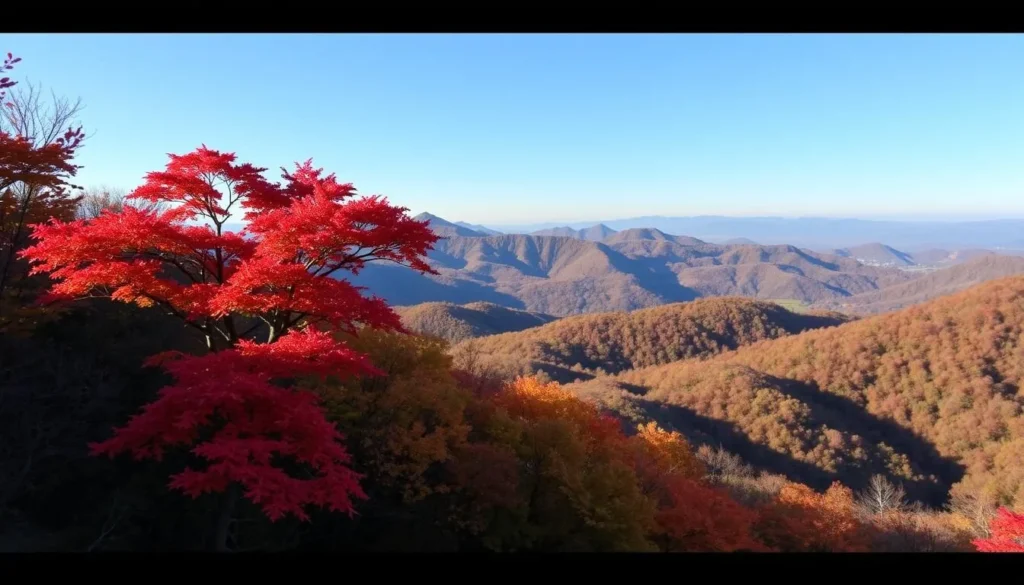
November: Cool Weather and Fewer Crowds
November continues the autumn color display in Mie Prefecture, with lower elevations reaching their peak foliage as temperatures cool further. The weather conditions remain pleasant, with temperatures averaging 10-18°C (50-64°F), though evenings become noticeably cooler. This combination of beautiful scenery, comfortable temperatures, and relatively low tourist numbers makes November one of the best months for visiting Japan and Mie Prefecture specifically.
The clear skies predominate, creating excellent visibility for mountain views and photography opportunities. Traditional autumn events and illuminations begin in preparation for the winter season, adding cultural interest to the natural beauty.
Winter in Mie Prefecture: December to February
The winter season in Mie Prefecture is characterized by mild temperatures and festive celebrations. You can expect a serene landscape, with temperatures ranging from 3-11°C (37-52°F), making it an ideal time for certain activities.
December: Early Winter and Year-End Festivities
December marks the beginning of winter in Mie Prefecture, with average temperatures gradually decreasing. You can enjoy year-end festivities and early winter illuminations, creating a magical atmosphere in urban areas. Popular spots like Suzuka Forest Garden start to get ready for the winter season, offering a glimpse into the beauty of the coming months.
January: New Year Celebrations and Winter Activities
January is a great time to experience the New Year celebrations in Mie Prefecture. You can visit shrines and temples, which are usually less crowded than during the peak summer months. The weather is generally sunny and dry, making it suitable for sightseeing. You can also enjoy winter activities such as visiting hot springs or taking part in traditional New Year festivities.
February: Cold Weather and Early Plum Blossoms
February represents the depth of winter in Mie Prefecture, though temperatures remain relatively moderate. By late February, plum trees (ume) begin to blossom, providing the first colorful signs that spring is approaching. You can visit popular plum blossom viewing spots, such as Suzuka Forest Garden and historical temples and shrines, to enjoy the beauty of these early flowers. Additionally, winter illumination events continue in urban areas, creating a magical nighttime experience despite the early sunset times.
Visiting Mie Prefecture in February offers several advantages. You can enjoy low-season rates at accommodations and minimal crowds at major attractions, except during the Lunar New Year period when Chinese tourism increases. The relatively mild winter weather, compared to northern Japan, makes it an attractive time to explore the region without the peak season crowds.
Mie Prefecture’s Famous Attractions and When to Visit Them
The timing of your visit can significantly impact your experience at Mie’s most celebrated attractions. Mie Prefecture is renowned for its rich cultural heritage and natural beauty, offering a diverse range of experiences throughout the year.
Ise Grand Shrine: Optimal Visiting Seasons
Ise Grand Shrine is one of Japan’s most sacred sites, and visiting it requires some planning. The shrine is dedicated to the sun goddess Amaterasu and is rebuilt every 20 years, a process known as Shikinen Sengu.
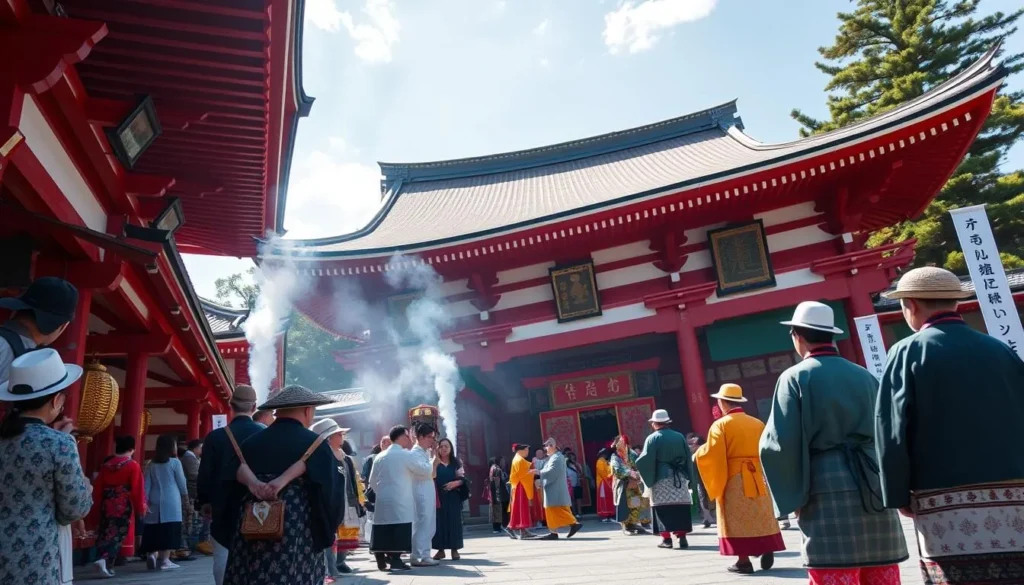
The best time to visit Ise Grand Shrine is during the spring (March to May) or autumn (September to November), when the weather is mild and comfortable. Avoid visiting during peak travel seasons like Golden Week and Obon, as the shrine can get crowded.
Mikimoto Pearl Island: Weather Considerations
Mikimoto Pearl Island is famous for its pearl cultivation and offers a unique experience for visitors. The island is particularly beautiful during the spring and summer months when the weather is warm, making it ideal for outdoor activities.
The island hosts various events throughout the year, including pearl harvesting demonstrations. Visiting during the shoulder season (April to May or September to October) can provide a more relaxed experience.
Ninja Museum in Iga: Year-Round Appeal
The Iga-ryu Ninja Museum is a must-visit attraction for history buffs and families alike. The museum showcases the history and culture of the ninja, with exhibits featuring ninja tools, costumes, and techniques.
The museum’s indoor exhibitions make it an excellent choice regardless of the month you visit. Summer brings special ninja performances, particularly during school holidays. Weekdays generally offer a less crowded experience, allowing more time to interact with exhibits.
Mie Prefecture, Japan: Best Months for a Weather-Savvy Trip
The best months to visit Mie Prefecture, Japan, are those that offer the most favorable weather conditions for travel. Planning your trip during the right time can significantly enhance your experience.
April-May: Ideal Spring Conditions
Spring is a wonderful time to visit Mie Prefecture. During April and May, the region enjoys mild temperatures, making it ideal for outdoor activities and sightseeing. The average high temperature is around 22°C (72°F), while the average low is about 12°C (54°F), creating comfortable conditions for exploring the area without the need for heavy clothing.
The spring season also brings beautiful blossoms, enhancing the natural beauty of Mie Prefecture. With moderate humidity levels and generous daylight hours (approximately 12-14 hours), you can make the most of your days exploring the region’s attractions.
October-November: Perfect Autumn Experience
Autumn is another excellent season to visit Mie Prefecture, with October and November offering pleasant weather. The temperatures are mild, with average highs around 20°C (68°F) and lows around 10°C (50°F), making it comfortable for all-day exploration.
The autumn foliage during these months is spectacular, providing a picturesque backdrop for your travel experiences. The relatively low rainfall and moderate humidity during this period ensure that you have plenty of clear days to enjoy the outdoors.
Weather Factors That Make These Months Ideal
Several weather factors contribute to making April-May and October-November the best months to visit Mie Prefecture. These include:
- Mild temperatures, eliminating the need for heavy clothing while remaining comfortable for all-day exploration.
- Low average rainfall outside of winter, maximizing the number of clear days for sightseeing and outdoor activities.
- Moderate humidity levels, avoiding both the stickiness of summer and the dryness of winter.
- Generous daylight hours (approximately 12-14 hours), providing ample time for sightseeing without early sunsets.
- Photogenic natural conditions, whether it’s spring blossoms or autumn foliage, enhancing your travel experience and photographs.
By visiting during these periods, you can enjoy Mie Prefecture’s attractions and natural beauty under optimal weather conditions, making your trip a memorable experience when visiting Japan.
| Month | Average High Temp (°C) | Average Low Temp (°C) | Rainfall (mm) |
|---|---|---|---|
| April | 18 | 8 | 120 |
| May | 22 | 12 | 140 |
| October | 20 | 10 | 130 |
| November | 15 | 5 | 90 |
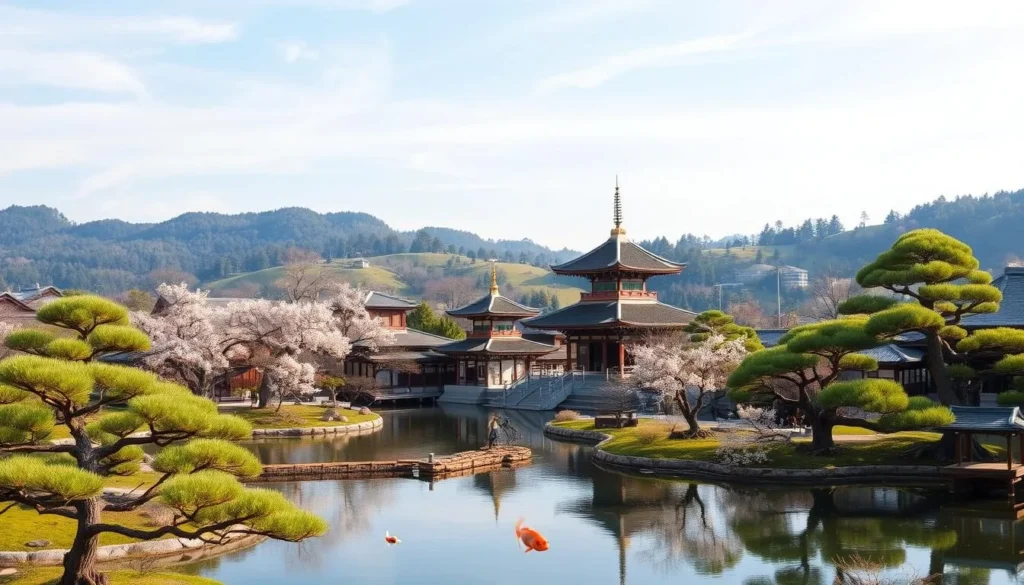
Worst Times to Visit Mie Prefecture (Weather-Wise)
While Mie Prefecture is a year-round destination, certain periods are less ideal due to weather conditions. Understanding these periods can help you plan a more enjoyable trip.
Rainy Season Challenges: Late June to Early July
The rainy season, which typically spans from late June to early July, brings significant challenges for visitors. During this month, Mie Prefecture experiences increased rainfall, leading to potential disruptions in outdoor activities. The continuous rain can make sightseeing less enjoyable and may limit access to certain attractions.
Here are some key considerations for visiting during the rainy season:
- Frequent rain showers can dampen outdoor plans.
- Some attractions may be closed or have limited access.
- The humidity can be quite high, making the weather feel uncomfortable.
| Aspect | Rainy Season (Late June – Early July) |
|---|---|
| Weather Conditions | Frequent rain, high humidity |
| Outdoor Activities | Limited due to rain |
| Attraction Accessibility | Some attractions may be closed or have limited access |
Extreme Heat and Humidity: August
August is another challenging month to visit Mie Prefecture due to the extreme hot humid weather. Temperatures often soar above 33-37°C (91-99°F), accompanied by oppressive humidity, making outdoor sightseeing uncomfortable, especially during peak sun hours (11am-3pm).
Visiting during August means:
- Dealing with summer heat that can be overwhelming.
- Encountering large crowds of tourists during the Obon festival.
- Higher accommodation prices due to peak season demand.
To make the most of your visit in August, consider planning your activities during the early morning, taking breaks in air-conditioned spaces, and staying hydrated. Focusing on coastal areas like the Shima Peninsula can also provide some relief due to the sea breezes.
Traveling to Mie During Japanese Holidays: What to Expect
Mie Prefecture transforms during Japan’s major holidays, offering both challenges and opportunities for travelers. Japan’s holidays can significantly impact your travel experience, with crowds, closures, and unique cultural events.
Golden Week (Late April to Early May)
Golden Week is a peak travel period in Japan, with many locals taking time off to travel. You can expect Mie Prefecture to be busier than usual, especially around popular spots like Ise Grand Shrine. While the crowds might be challenging, the pleasant spring weather makes it an ideal time to enjoy outdoor activities and festivals. It’s advisable to book accommodations and transportation in advance to avoid any inconvenience.
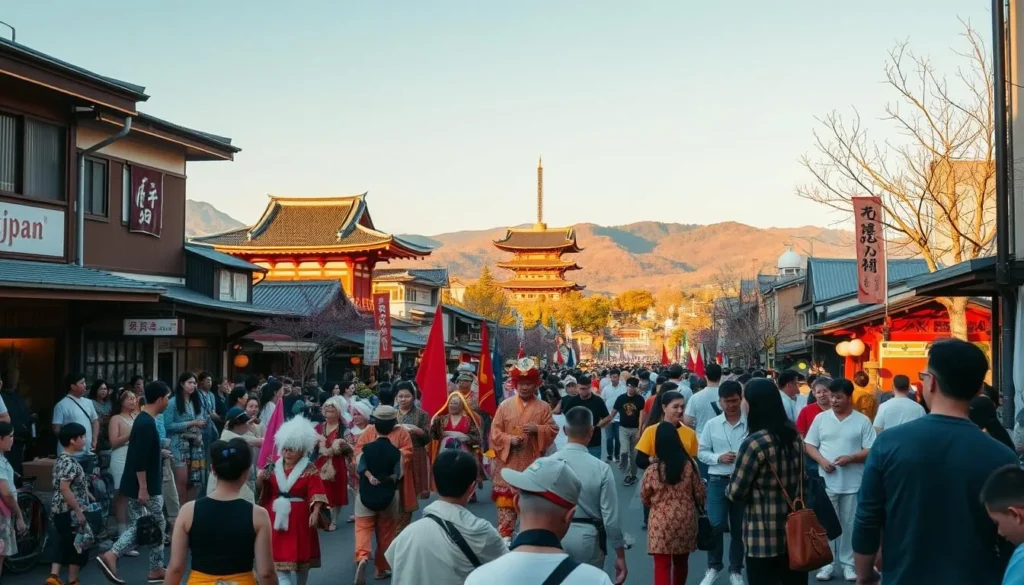
Obon Festival (Mid-August)
Obon is a significant Buddhist holiday honoring the spirits of one’s ancestors. During Obon, many Japanese people return to their hometowns, leading to busy transportation systems. In Mie Prefecture, you can experience traditional Obon dances and festivities. However, the summer heat and humidity are at their peak, so be prepared for challenging weather conditions.
| Holiday | Weather | Expectations |
|---|---|---|
| Golden Week | Pleasant spring weather | Crowds, festivals, outdoor activities |
| Obon Festival | Hot and humid | Traditional dances, busy transportation |
| New Year | Cold winter weather | Hatsumode, closed businesses, unique cultural experiences |
New Year Holiday Season (December 29 – January 3)
The New Year (new year) holiday season is one of Japan’s three major travel seasons, with intensive domestic and international travel activity. Many shops, restaurants, and attractions are closed for at least one day between December 29 and January 4. Major shrines in Mie Prefecture, particularly Ise Grand Shrine, become extremely busy with hatsumode (first shrine visit of the year) visitors, especially on January 1-3. While many businesses close, visiting during the New Year offers unique cultural experiences, including special shrine ceremonies and traditional New Year foods and customs.
When traveling to Mie during the New Year holiday, it’s essential to plan ahead. Many people travel to their hometowns, making transportation systems extremely busy. Advance reservations for trains and accommodations are crucial. Despite the challenges, experiencing winter in Mie can be rewarding, with fewer tourists at some attractions and a serene winter landscape.
Packing Guide for Mie Prefecture by Season
Mie Prefecture’s diverse climate across seasons requires thoughtful packing to ensure a comfortable trip. Understanding what to expect in terms of weather during your visit will help you prepare the right clothing and essentials.
Spring Essentials
During spring (March to May), Mie Prefecture experiences mild temperatures, making it an ideal time to visit. You should pack:
- Lightweight clothing for warmer days
- Layers for cooler mornings and evenings
- Comfortable shoes for walking
- Umbrella or raincoat for occasional spring showers
As spring progresses, the weather becomes more stable, but it’s still a good idea to be prepared for unexpected rain showers.
Summer Must-Haves
Summer in Mie Prefecture (June to August) is characterized by hot and humid weather. Your packing list should include:
- Lightweight, breathable clothing
- Sun protection (sunscreen, hat, sunglasses)
- Insect repellent to protect against mosquitoes
- Swimwear for enjoying the prefecture’s beaches and water activities
Summer is also the season for various festivals, so be prepared for crowds and festivities.
Autumn Clothing Tips
Autumn (September to November) brings comfortable temperatures to Mie Prefecture, making it another excellent time to visit. Pack:
- Layers for the cooler mornings and evenings
- Comfortable clothing for outdoor activities like hiking
- Waterproof gear for potential autumn rain
Autumn is known for its beautiful fall foliage, so consider bringing a camera to capture the scenery.
Winter Packing List
Winter (December to February) in Mie Prefecture is relatively mild compared to other parts of Japan, but it still requires warm clothing. Don’t forget:
- A good quality winter coat
- Thermal underwear and sweaters for layering
- Scarf, gloves, and hat for protection against cold winds
- Waterproof shoes or boots for potential light snow in mountainous areas
- Lip balm and moisturizer to combat dry winter air
| Season | Essential Items |
|---|---|
| Spring | Lightweight clothing, layers, comfortable shoes, umbrella |
| Summer | Breathable clothing, sun protection, insect repellent, swimwear |
| Autumn | Layers, comfortable clothing, waterproof gear |
| Winter | Winter coat, thermal underwear, scarf, gloves, hat, waterproof shoes |
By packing according to the season, you’ll be well-prepared for your trip to Mie Prefecture and can enjoy all that this beautiful region has to offer.
Mie Prefecture’s Seasonal Cuisine
As the seasons change in Mie Prefecture, so does the local cuisine, offering a diverse range of flavors. The prefecture’s geographical location, with its rich agricultural land and access to fresh seafood, contributes to its culinary richness. Visitors can enjoy a variety of dishes throughout the year, each reflecting the best of the season’s produce.
Spring Delicacies
Spring in Mie Prefecture brings a variety of fresh produce, including sansai (mountain vegetables) and fresh fish from the sea. One of the highlights is the hanami dango, sweet dumplings traditionally eaten during cherry blossom viewing. Spring is also the time for ayu, a sweet fish often grilled over charcoal. The season’s bounty is celebrated in local dishes that are both flavorful and visually appealing.
Summer Food Specialties
Summer in Mie Prefecture is characterized by hot and humid weather, making cooling dishes a staple. Ise udon, thick wheat flour noodles served in a hot broth or cold, are a popular summer treat. The prefecture’s coastline provides an abundance of fresh seafood, including shirasu (whitebait) and aji (horse mackerel), often served raw or grilled. Summer festivals often feature grilled foods and cold desserts, perfect for the season.
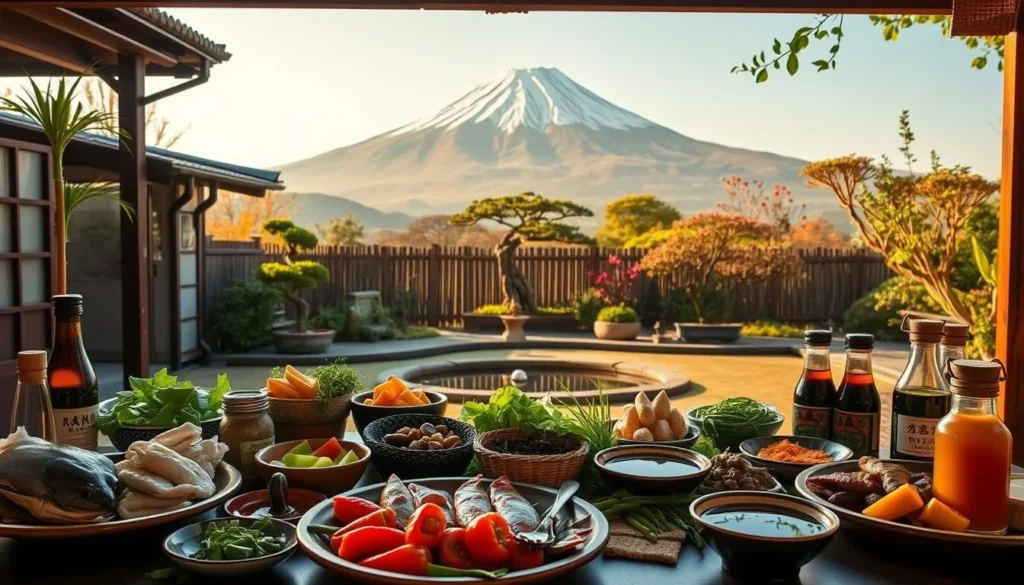
Autumn Harvest Dishes
Autumn in Mie Prefecture is a season of harvest, with a focus on hearty dishes that warm the body. The season brings matsutake mushrooms, highly prized for their unique flavor and aroma, often used in soups and rice dishes. Kakinoha persimmon leaves are used to wrap sushi, adding a distinct flavor. Autumn is also a time for nabe (hot pot) dishes, featuring seasonal ingredients like mushrooms and root vegetables.
Winter Comfort Foods
Winter brings hearty, warming dishes to Mie Prefecture’s culinary landscape. Nabe (hot pot) becomes a staple, with local variations featuring regional ingredients like Matsusaka beef, one of Japan’s premium wagyu varieties. Oysters from Ise Bay reach their peak flavor in winter, served grilled, in hot pots, or raw. The New Year brings special osechi ryori (traditional New Year foods), each with symbolic meaning for prosperity in the coming year. Warm sake is particularly popular during winter, often paired with grilled seafood or hearty stews.
Outdoor Activities in Mie Prefecture by Season
As you plan your trip to Mie Prefecture, you’ll find that each season brings its unique outdoor activities and experiences. Whether you’re looking for adventure, relaxation, or cultural exploration, Mie has something to offer throughout the year.
Spring Hiking and Nature Walks
Spring is a wonderful time to explore Mie’s natural beauty through hiking and nature walks. The mild weather and blooming flowers make it an ideal season for outdoor activities. You can hike in the mountains, visit the cherry blossom spots, or simply take a leisurely walk in one of Mie’s many parks.
Summer Beach and Water Activities
Summer in Mie Prefecture is perfect for beachgoers and water sports enthusiasts. The prefecture is home to several beautiful beaches, such as those in the Ise-Shima region, where you can enjoy swimming, surfing, or simply relaxing by the sea. Some of the best beaches include:
- Binary Beach
- Amano Hashidate Beach
- Kokumin Shirahama Beach
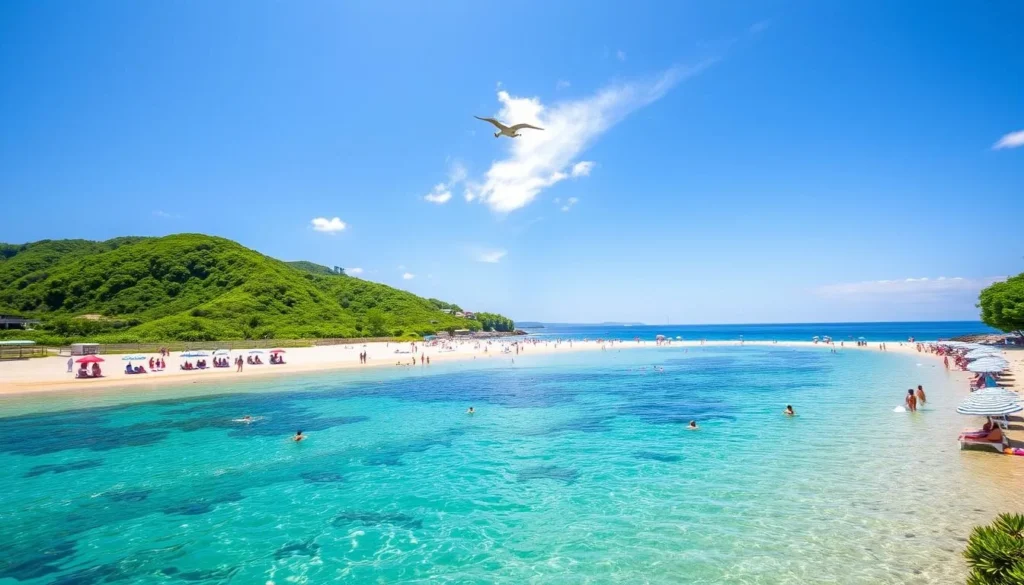
Autumn Trekking and Photography
Autumn brings a kaleidoscope of colors to Mie’s landscapes, making it a great time for trekking and photography. The comfortable temperatures and scenic views provide a perfect backdrop for outdoor adventures. You can explore the mountains, forests, and rural areas, capturing the beauty of the changing foliage.
Winter Hot Springs and Indoor Attractions
Winter in Mie Prefecture brings a shift toward indoor activities and the enjoyment of natural hot springs (onsen) that are particularly appealing in cooler weather. You can visit famous hot spring areas like Yunoyama Onsen, which offers both public baths and ryokan with private facilities, perfect for warming up on a cold winter day. While Mie doesn’t receive heavy snowfall like northern Japan, the occasional light snow in mountainous areas creates beautiful winter landscapes for photography. Indoor cultural attractions like the Ninja Museum in Iga, Mikimoto Pearl Museum, and various traditional craft workshops provide enriching experiences protected from the winter weather. Additionally, winter illumination events in cities like Tsu, Yokkaichi, and Ise create magical nighttime experiences that compensate for the season’s shorter daylight hours.
Mie Prefecture’s Seasonal Festivals and Events
Experience the best of Mie Prefecture through its seasonal festivals and events, each offering a distinct glimpse into the local way of life. Throughout the year, the prefecture comes alive with celebrations that reflect its rich cultural heritage and traditions.
Spring Celebrations
In the spring, Mie Prefecture welcomes the season with various festivals. The cherry blossom season is a highlight, with many parks and gardens hosting viewing parties. You can enjoy the beautiful blooms at popular spots like Ise Grand Shrine and Mikimoto Pearl Island. Spring is also a time for renewal, with many events centered around the theme of new beginnings.
Summer Matsuri
Summer in Mie Prefecture is marked by vibrant matsuri (festivals) that take place in towns and cities across the region. These events often feature traditional dances, food stalls, and fireworks displays. The Obon Festival in mid-August is a significant event, honoring the spirits of ancestors with lively performances and ceremonies. You can immerse yourself in the local culture by participating in these festivities.
Autumn Festivals
Autumn brings a range of festivals to Mie Prefecture, celebrating the harvest season. Many of these events are centered around the local produce, with food festivals showcasing the region’s specialties. You can sample delicious dishes and drinks while enjoying the autumn foliage, making for a memorable experience.
Winter Events
Winter festivals and events in Mie Prefecture often center around New Year celebrations and illumination displays that brighten the season’s long nights. The New Year period brings hatsumode (first shrine visit) crowds to Ise Grand Shrine, one of Japan’s most important spiritual destinations for starting the year. You can also enjoy winter illumination events that transform urban parks and shopping districts throughout Mie, with Nabana no Sato featuring one of Japan’s most spectacular light displays. Additionally, the Iga Ueno Ninja Festa in February celebrates the region’s ninja heritage with special performances and activities.
Accommodation Tips for Different Seasons in Mie
To make the most of your visit to Mie, it’s essential to understand the accommodation options available during different seasons. Mie Prefecture offers a wide range of accommodations, from traditional Japanese ryokans to modern hotels, each with its unique charm and advantages.
Peak vs. Off-Peak Pricing
Accommodation prices in Mie fluctuate significantly with the seasons. During peak seasons such as cherry blossom season, Golden Week, Obon, and autumn foliage, prices tend to be higher, and availability is limited. In contrast, during the off-peak seasons, you can find more affordable rates and a wider range of options. For instance, visiting during the spring or autumn can offer a more relaxed experience and better value for money.
| Season | Average Price Range | Availability |
|---|---|---|
| Peak Season (Cherry Blossom, Golden Week, Obon, Autumn Foliage) | $150-$300 per night | Limited |
| Off-Peak Season | $80-$150 per night | High |
Best Areas to Stay by Season
The best area to stay in Mie can vary depending on the season and your interests. For example, during the cherry blossom season, staying near the major viewing spots like Tsu or Ise can enhance your experience. In contrast, during the summer, areas near the coast, such as Shima or Matsusaka, offer better access to beach activities.
Spring: Consider staying in areas known for their cherry blossoms, such as Tsu or Ise.
Summer: Areas near the coast, like Shima or Matsusaka, are ideal for beachgoers.
Booking Recommendations and Timing
Booking your accommodation at the right time is crucial, especially during peak seasons. It’s recommended to book at least 3-6 months in advance to secure your preferred accommodation. Utilizing booking platforms that offer free cancellation options can also provide flexibility, especially when traveling during uncertain weather periods.
- Book accommodations at least 3-6 months in advance for peak seasons.
- Consider Japanese-style ryokans for an authentic cultural experience.
- Use booking platforms with free cancellation options for flexibility.
By planning ahead and choosing the right accommodation for your travel time, you can significantly enhance your experience in Mie Prefecture. Whether you’re visiting Japan in the spring, summer, autumn, or winter, there’s a way to make your trip memorable and enjoyable.
Day Trips from Mie Prefecture: Seasonal Considerations
As you plan your trip to Mie Prefecture, consider expanding your itinerary with exciting day trips to nearby destinations. Mie Prefecture’s central location in Japan makes it an ideal base for exploring the surrounding regions, each with its unique charm and attractions.
Spring Day Trip Options
Spring is a wonderful time to explore the areas around Mie Prefecture. You can visit Nara, famous for its historic temples and friendly deer, or enjoy the beautiful gardens and traditional architecture of Kyoto. Another great option is Nagoya, known for its castle and modern attractions.
Summer Excursions
During the summer, consider day trips to coastal areas like Ise-Shima National Park for beach activities or Toba for its aquariums and marine life. For a cooler retreat, visit the mountains of Gifu Prefecture or enjoy water sports on Lake Biwa.
Autumn Adventures
Autumn brings vibrant foliage to the regions around Mie. Take a day trip to Kyoto to admire the fall colors at temples and gardens, or visit Nikko for its ornate temples and beautiful fall landscapes. The Japanese Alps in Gifu Prefecture also offer stunning autumn views.
Winter Day Trips
Winter opens up opportunities for cultural and illuminations-focused day trips. Visit Nagoya for its museums and indoor attractions, or enjoy the spectacular winter illuminations at Nabana no Sato in Kuwana. For those interested in winter sports, Gifu Prefecture’s ski resorts are within reach. You can also visit major shrines and temples in Kyoto, Nara, or Osaka during the New Year for a meaningful experience.
By considering these seasonal day trip options, you can enrich your travel experience in Mie Prefecture and explore the best of what central Japan has to offer throughout the year.
Conclusion: Planning Your Weather-Perfect Trip to Mie Prefecture
As you plan your trip to Mie Prefecture, understanding the nuances of its climate is key to a memorable experience. The best time to visit Mie for most travelers falls within two sweet spots: late April to May, after Golden Week, and October to November, when weather conditions are most comfortable and natural beauty is at its peak.
It’s also important to consider avoiding the challenging weather periods of rainy season (late June to mid-July) and peak summer heat (August), unless you’re interested in specific festivals that take place during these times. Being strategic about Japanese holidays like New Year, Golden Week, and Obon can also enhance your experience, either by embracing the cultural events or planning to avoid the crowds and higher prices.
Regardless of when you visit, Mie Prefecture offers authentic experiences away from Japan’s most tourist-heavy destinations. You’ll have a deeper connection to Japanese culture, cuisine, and natural beauty throughout the year. Whether you’re drawn by the delicate cherry blossom season or the vibrant autumn foliage, Mie Prefecture rewards weather-savvy travelers with memorable experiences in one of Japan’s most diverse regions.
By balancing your travel preferences with seasonal considerations, you can create your ideal Japanese experience in Mie Prefecture. With its rich cultural heritage and varied landscapes, Mie is a destination that offers something unique throughout the year, making it an ideal time to visit Japan.
